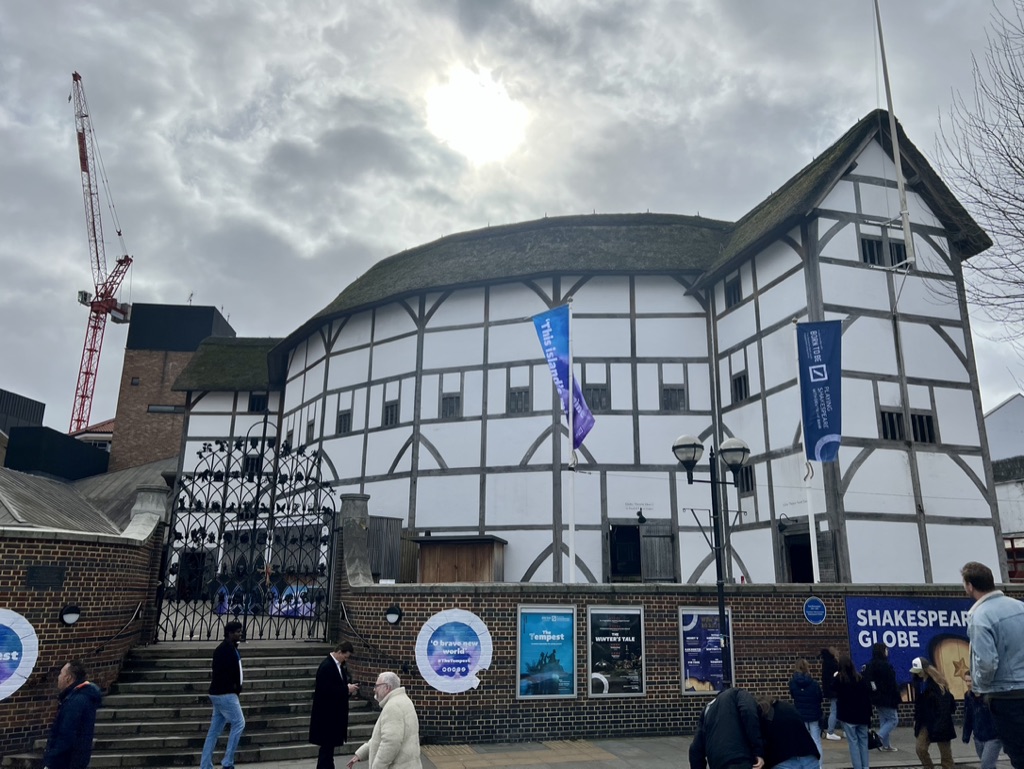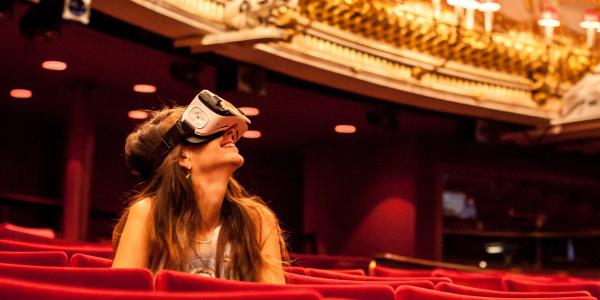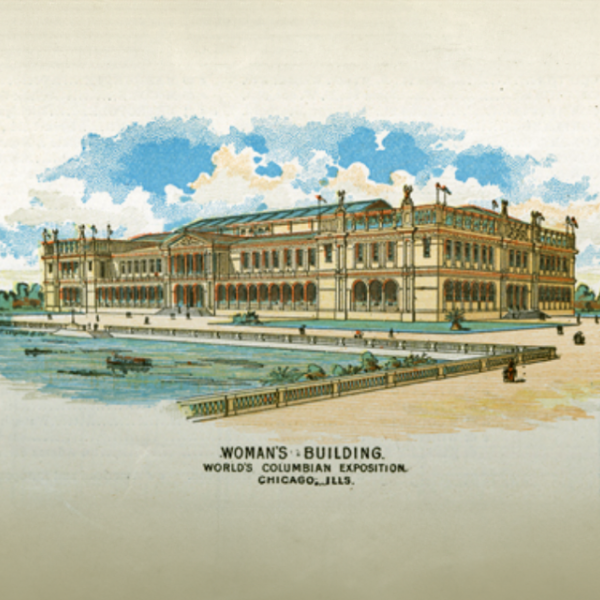Interview with Faculty Fellow Elizabeth Hunter
“What happens when we inhabit the world of a famous story and the story seeps into our own?” asks Faculty Fellow Elizabeth Hunter, an assistant professor of drama in the Performing Arts Department. That’s the question at the heart of her book-in-progress, “Acting the Part: Audience Participation in Performance.” By analyzing performances of Shakespeare’s plays and Greek tragedies in four 21st-century contexts — a reconstructed historical playhouse, open-world theatre, virtual reality and augmented reality — her book proposes a new theory of spectatorship. “Enactive spectatorship,” a term she has coined, describes the sense of being cast in a role, as an audience member, in a live retelling of a well-known story.
How is “enactive spectatorship” different from active participation?
Audience participation is a part of any live theatrical production. Behaviors like paying attention, laughing in the right spots or clapping at the end are all part of going to a show. However, the last 20 years of Western theatre have seen a rise in productions with more extensive participation. Audiences might perambulate freely through a designed space, for example, or find an actor inviting them to hold a prop or say something aloud.
In my field of theatre and performance studies, scholarship has tended to consider audience participation “meaningful” only when it involves co-authoring or changing the unfolding story in some way. But “changing the story” does not describe what happens when audiences participate in a production of a story that is canonical (that is, highly recognizable as culturally significant to certain groups). I am interested in productions that attempt both of these goals: participation that registers as meaningful and a portrayal of a canonical story. The argument of “Acting the Part” is that productions like these foster a sense of enacting a role in the narrative, however minor — hence, enactive spectatorship.
You’re looking specifically at known works such as Shakespeare’s plays and ancient Greek tragedies. Why is this factor important to your theory?
I use the plays of William Shakespeare and ancient Greek tragedies as a shorthand for canonical text for two reasons: first, because of my own positionality as an English speaker trained in a Western tradition. Second, these sources are likely to be broadly familiar to “Acting the Part’s” primary readerships, so they can serve as a control variable that allows me to focus on the structures of the production. But canonicity is not universal. Sources that would register as canonical to other audiences might include the Mahābhārata and Rāmāyaṇa, or Noh plays.
Whether Shakespeare or Noh, canonical stories are often attended by arguments over the faithfulness or accuracy of any one portrayal. And when these portrayals take place in live contexts, the stakes are measured in bodies, not bytes. A goal of “Acting the Part,” then, is to map a theoretical model of participatory spectatorship that can be adapted for use across canonical sources.

Can you set the scene (so to speak) for us? Help us imagine the experience of attending a performance that encourages “enactive spectators.” How do those cues direct spectators to their expected role in that setting? Are these guideposts available only in productions using augmented reality or virtual reality?
One of the reasons “Acting the Part” analyzes contexts that are physical, like the reconstructed Globe Theatre in London, as well as digital, like the social virtual reality productions Finding Pandora X and Tempest, is that the dynamic I’m tracing does not rely on specific technologies. Rather, it arises from a combination of four factors: a historically resonant site, a canonical source represented faithfully in some way, production choices that create immersivity, and identifiable tasks and rewards that have value within the economy of the production.
It can be helpful to think of these as levers — and to shape what audience members do and when, producers can pull on these levers with varying intensity. For example, the way the reconstructed Globe pulls on these levers can support only brief flickers of this dynamic. In a production of Macbeth, this might manifest when the Porter names three professions who are in hell. As this chapter explains, the nature of the Globe is such that an actor cannot help but point out a specific audience member as each profession: “Here’s a farmer, that hanged himself on th’ expectation of plenty,” he yells. “Faith, here’s an equivocator … Here’s an English tailor…” And for that brief moment, that audience member is the profession the Porter named them.
But as the chapter on social virtual reality theatre explains, the nature of this technology allows producers to situate audience members in a more central role. In Tempest, for example, the Prospero avatar invites individual audience avatars to act out the principal characters of Ferdinand or Miranda for a few moments. Importantly, regardless of the intensity with which a production exhibits this quality, a host of power structures and stakeholders sit behind the slippery terms that are part of this dynamic, like “resonant,” “faithfully,” “value” and so on. One of my goals for this critical model is for it to illuminate some of these entities, because they can easily pose as neutral.

How does your past and current experience as a creator and director impact your scholarly work in this area?
My interest in understanding this kind of audience participation is a direct result of my experience as a practitioner. The catalyst for my return to academia was a theatre project I started at a restored blast furnace in Birmingham, Alabama, Sloss Furnaces National Historic Landmark. As a site for making theatre, Sloss is astonishing. It is a 20-acre campus of towering, industrial-era furnaces and blast stoves, rich in deep rusted orange, corroded gray and faded maroon, where kudzu and thorny vines twine through the smallest gap and visitors wander mostly unsupervised.
My first theatrical endeavor at Sloss was to stage a Shakespeare-themed walking tour through the site. Small groups of audience members, provisioned with wine and snacks from a local chef, followed a guide along a predetermined path that wound past Sloss’ skip hoists, slag pit, blowing engine building and other industrial relics. At certain locations along this path — under the ramshackle stanchions of abandoned train bridges, perhaps, or in Sloss’ allegedly haunted underground tunnel — the tour guide stopped the group to watch a scene from one of Shakespeare’s plays.
One of these scenes was Henry V’s Act 3, Scene 1, which is King Henry’s speech at the gates of Harfleur. In this rousing monologue, the king exhorts his bedraggled, outnumbered English army to charge “once more unto the breach” and take the city, a victory that is the turning point in their war with the French. At Sloss, I set this scene along one of the most visually arresting vistas: a 50-yard straightaway flanked on either shoulder by a row of red I-beam arches. As the audience assembled, King Henry, played by Sylvester Little Jr., leapt into their midst from a berm at stage right, clad in a green 1950s flight suit and waving a forged iron staff from Sloss’ metal artists.
What had we done to make them feel so strongly that they were in the story? And more importantly, how could we do it again?
Just as Little Jr. began to speak, a freight train blasted past 15 feet up the berm. Using the train as an excuse to get closer to the group, Little Jr. wove through them with familiarity, putting his arm around an audience member or two and paying extra attention to the three children in attendance. At Henry’s concluding “Cry God for Harry, England, and Saint George!” Little Jr. made the impromptu decision to sprint down the straightaway, howling a war cry, rather than hop back over the berm as we had discussed. This exit so inspired one of the young boys in the group that he ran after Little Jr., screaming “SAINT GEORGE!” at the top of his lungs. As if on cue, the rest of the group followed suit, shrieking and cheering as they ran to the next location.
What had we done to make them feel so strongly that they were in the story? And more importantly, how could we do it again? In my scholarship and in my continuing practice, I think I have been answering these questions ever since.





